
Diego Rodríguez de Silva y Velázquez, Knight of the Order of Santiago was a Spanish painter, the leading artist in the court of King Philip IV of Spain and Portugal, and of the Spanish Golden Age.

Las Meninas is a 1656 painting in the Museo del Prado in Madrid, by Diego Velázquez, the leading artist of the Spanish Baroque. It has become one of the most widely analyzed works in Western painting for the way its complex and enigmatic composition raises questions about reality and illusion, and for the uncertain relationship it creates between the viewer and the figures depicted.

The Rokeby Venus is a painting by Diego Velázquez, the leading artist of the Spanish Golden Age. Completed between 1647 and 1651, and probably painted during the artist's visit to Italy, the work depicts the goddess Venus in a sensual pose, laying on a bed with her back facing the viewer, and looking into a mirror held by the Roman god of physical love, her son Cupid. The painting is in the National Gallery, London.

Margaret Theresa of Spain was, by marriage to Leopold I, Holy Roman Empress, German Queen, Archduchess of Austria and Queen of Hungary and Bohemia. She was the daughter of King Philip IV of Spain and the elder full-sister of Charles II, the last of the Spanish Habsburgs. She is the central figure in the famous Las Meninas by Diego Velázquez, and the subject of many of his later paintings.

Juan Bautista Martínez del Mazo was a Spanish Baroque portrait and landscape painter, the most distinguished of the followers of his father-in-law Velázquez, whose style he imitated more closely than did any other artist. A fine painter himself, Mazo was a master of landscape, as proven by his most celebrated work View of Saragossa.

Gaspar de Guzmán, Count-Duke of Olivares, on Horseback is an oil on canvas painting by Spanish painter Diego Velázquez, made around the year 1636. It has been in the Museo del Prado in Madrid since its inauguration in 1819.
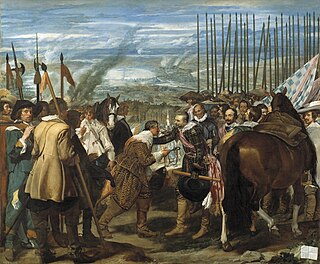
La rendición de Breda is a painting by the Spanish Golden Age painter Diego Velázquez. It was completed during the years 1634–35, inspired by Velázquez's visit to Italy with Ambrogio Spinola, the Genoese-born Spanish general who conquered Breda on June 5, 1625. The painting depicts the exchange of the key of Breda from the Dutch's possession, to the Spanish.
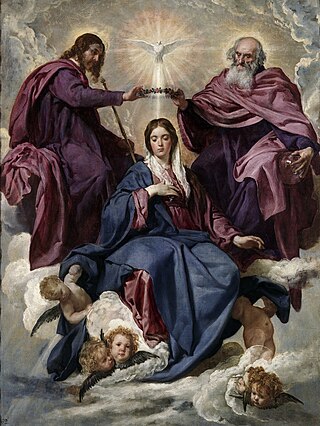
The Coronation of the Virgin is a 1635–1636 painting on oil on canvas by Diego Velázquez of the Holy Trinity crowning the Blessed Virgin Mary, a theme in Marian art. It is now at the Museo del Prado.
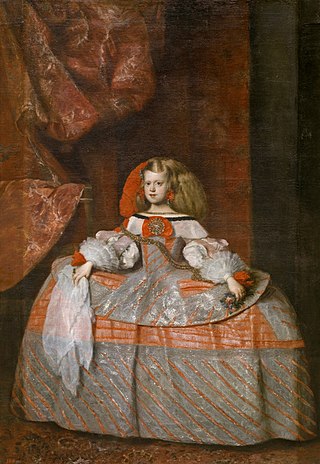
Infanta Margarita Teresa in a Pink Dress is a 1660 oil on canvas portrait of Margaret Theresa of Spain by the Spanish painter Diego Velázquez, though his identification as its author is not considered secure. It is now in the Prado Museum in Madrid.

The Kitchen Maid and Kitchen Maid with the Supper at Emmaus are two paired domestic paintings by Diego Rodríguez de Silva y Velázquez from his early Seville period. A wide range of dates has been suggested for its completion, although most place it between 1620 and 1622. The first version is kept in the Art Institute of Chicago; the second version is held at the National Gallery of Ireland.

Portrait of Pablo de Valladolid is a portrait painted around 1635 by Diego Velázquez of Pablo or "Pablillos" de Valladolid (1587–1648), a jester and actor at Philip IV's court from 1632 until his death. It is now in the Museo del Prado, to which it was moved in 1827.
Las Meninas is a series of 58 paintings that Pablo Picasso painted in 1957 by performing a comprehensive analysis, reinterpreting and recreating several times Las Meninas by Diego Velazquez. The suite is fully preserved at the Museu Picasso in Barcelona and is the only complete series of the artist that remains together. This is a very extensive survey work, which consists of 45 performances of the original picture, 9 scenes of a dove, 3 landscapes and a portrait of Jacqueline.

Venus with a Mirror is a painting by Titian, now in the National Gallery of Art in Washington, DC, and it is considered to be one of the collection's highlights.
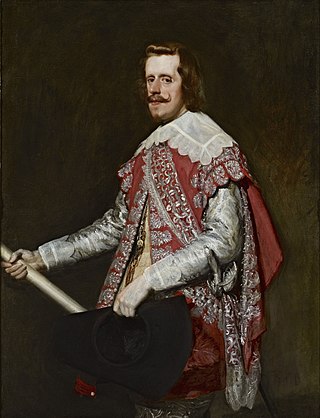
The Portrait of Philip IV in Fraga is a mid-length portrait of Philip IV of Spain by Velázquez. It was painted over the course of three sessions in June 1644 in Fraga, where Philip IV had moved the royal court as part of the "Jornada de Aragón" which resulted in the recovery of Lérida from France, which had occupied the city earlier during the Reapers' War. The portrait was gifted by Philip V to his son, the future Philip, Duke of Parma, and the painting left Spain along with him in 1748. In 1911 it was acquired by the Frick Collection, where it is currently on display.
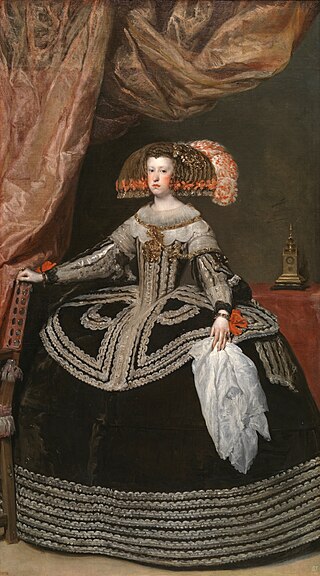
Portrait of Mariana of Austria is a 1652–1653 oil-on-canvas painting by Diego Velázquez, the leading artist of the Spanish Golden Age, existing in a number of versions. Its subject, Doña Mariana, was the daughter of Emperor Ferdinand III and Maria Anna of Spain. She was nineteen years old when the painting was completed. Although described as vivacious and fun-loving in life, she is given an unhappy expression in Velázquez's portrait. The portrait is painted in shades of black and red, and her face is heavily made up. Her right hand rests on the back of a chair, and she holds a lace handkerchief in her left hand. Her bodice is decorated with jewellery, including a gold necklace, bracelets and a large gold brooch. A clock rests on scarlet drapery behind her, signifying her status and discernment.

Saint Paul is a painting by Diego Velázquez that is in the Museu Nacional d'Art de Catalunya in Barcelona, Spain. The piece was created around 1619 during the early stage of Velázquez's artistic career before he moved to Madrid. At this stage of Velazquez's career he was deeply influenced by Caravaggio. In the image, Saint Paul is seated holding a book, commonly referenced as a large Gospel book.

Portrait of Don Pedro de Barberana y Aparregui is an oil on canvas painting attributed to Velázquez and painted around 1631–1633. It has been in the Kimbell Art Museum in Fort Worth, Texas since 1981.
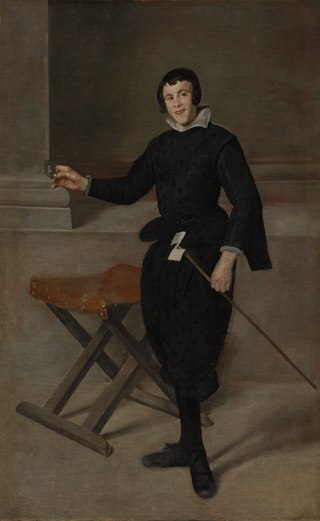
The Jester Calabacillas is a 1626-1632 oil on canvas painting by Diego Velázquez, now in the Cleveland Museum of Art. Its attribution is based on stylistic similarities to other works by the artist - for example, José López-Rey sees similarities in the treatment of the face in this work and that of Bacchus in The Triumph of Bacchus. Its subject is thought to be the jester Juan Calebasse, also painted by the artist in a work now in Madrid and a now-lost work entitled "calebasses in a turban", the latter recorded in 1642 and 1655 inventories of Diego Felipez de Guzmán's collection.

William Bryan Jordan Jr. was an American art historian who facilitated acquisitions, curated exhibitions, and authored publications on Spanish artists and still life paintings, particularly from the Golden Age.


















